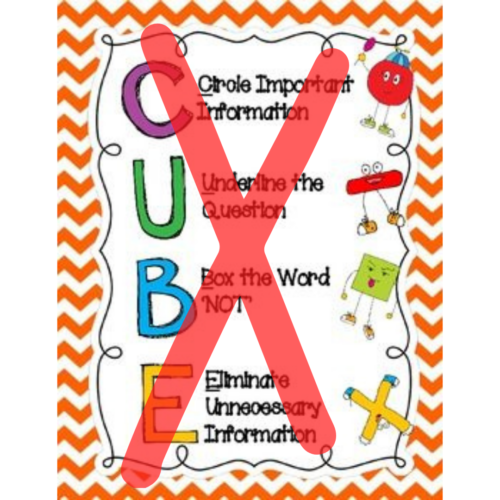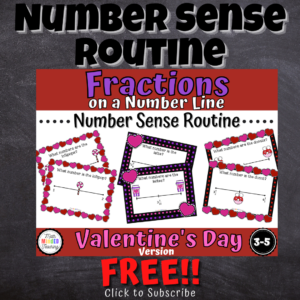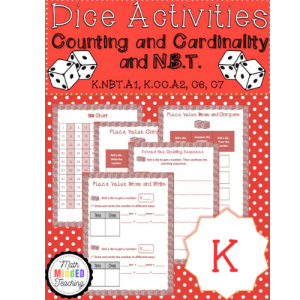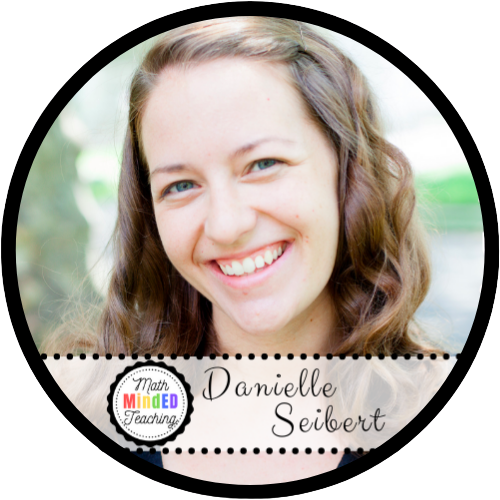There are many reasons why students might struggle with math, especially word problems. Students’ reading ability might hinder students from performing well in mathematics in regards to word problems. Students who struggle with reading might have issues comprehending the reading and therefore the word problems. Language may be another barrier for students to succeed with math word problems. Maybe a student is an English Language Learner, or the language of math is a barrier for them because they can’t understand it.
Another reason for students to struggle with math word problems might be perseverance because students give up before they even read a word problem. Another big barrier for students is confidence. Some students think they are not good at math, or they can’t do math, it’s too many words, it’s too hard, or I don’t know this. This negative self talk occurs in students with math anxiety. The question is, how can we build up students experience and confidence and lower the floor so that all students are able to engage in math word problems?
What does the research say?
According to Zwiers et al. (2017), effective mathematical language instruction is “grounded in the inter-dependency of language learning and disciplinary learning the central role of student agency in the learning process, the importance of scaffolding routines that foster students independent participation, and the value of instructional responsiveness in the teaching process.” Zwiers et al. (2017), suggest four design principles for promoting mathematical language use and development in curriculum and instruction include (1) supporting sense-making (2) optimizing output, (3) cultivating conversation and (4) maximizing linguistic and cognitive meta-awareness.
Many teachers have implemented the CUBE strategy or something similar in order to help students solve word problems. However, this strategy doesn’t work! Here’s an example of a problem: John and Carlos have been trading baseball cards. John gave Carlos 15 more of his cards to add to his collection. Carlos now has 76 cards. How many cards did Carlos have before John gave him some of his cards? C stands for circle circle all the numbers U stands for underlined the question B means box the numbers he means illuminate all unnecessary information. If we take those two numbers add them together it equals 91. However, the answer is not 91.

What happened? We did what the teacher told us to do. What was missing? This specific problem is a start unknown problem where we don’t know the start, but we know the change and the result. Therefore, the CUBE strategy does not work. What we should have done is actually subtract 76-15 to figure out a start. What could we have done differently?
instead of using the CUBE strategy, let’s discuss three other options for getting students to engage in math word problems; three reads strategy, numberless word problems, and three-act lessons.
Three Reads Strategy
One solution to getting students to engage in word problems is the three reads strategy. This is the math storytelling strategy where students start to think about math as contextual problems or stories that they are trying to comprehend and make sense of rather than question what they should do first. We want them to stop and think about what the problem is asking them to do. The purpose of the three reads strategy is to “ensure that students know what they are being asked to do, create opportunities for students to reflect on the ways mathematical questions are presented, and equip students with tools used to negotiate meaning” (Kelemanik, Lucenta & Creighton, 2016).
The first step in the three reads strategy is to do just what it says to actually read the problem three times, but each time with a different purpose. The first read is to ask what is the situation about? In this first step the students do not have the problem in front of them. They only listen to the problem and ask themselves what the situation is about. The second read students receive the question and then ask themselves what are the quantities in the search situation and how are they related? During the third read students are asked what are all the possible mathematical questions we could ask of this situation? Students then decide on one and then solve with a model or a diagram.
Numberless Word Problems
Brian Bushart has already created sets of numberless word problems which are organized around one specific CGI problem type. He even includes sample discussion questions in the notes section on each side. During numberless word problems the idea is that each side of a problem will reveal more of the problem and scaffold students to eventually understand the situation and question.
When having students explain their thinking and how they solve the problem it is best to encourage students to not use numbers when explaining how they solved it too. This challenges students to understand the problem and how they solved it. Students could use a part part whole strategy to explain their thinking or simply use words to explain how they would solve.
Three Act Lessons
Three Act Tasks were first made popular by Dan Meyer. A three act lesson scaffolds the language barrier for students. They also add engagement when students wonder what will happen next. Three acts allow for student discourse and estimation. It encourages students to use multiple strategies when solving a problem. And finally it engages students in mathematical modeling. Dan Meyer was gracious enough to organize a list of 3-Act Tasks primarily for grades 6-12. Here is the breakdown by act.
Act 1:
• Students pose question (WDYN & WDYW)
• Make estimates
Act 2:
• Identify missing or unknown variables
• Plan solution path
Act 3:
• Solve and interpret results
In addition to Dan Meyer, Graham Fletcher has taken 3-Act Tasks to a new level and introduced them in grades K-5. He has also been kind enough to organize a K-5 list of 3-Act Tasks by standard. Here are some others:
Geoff Krall (PBL Curriculum Maps)
I hope you try these three strategies the next time your students are struggling with math word problems to support sense making, optimize output, cultivate conversations, and maximize meta-awareness.
References
Kelemanik, G, Lucenta, A & Creighton, S.J. (2016). Routines for reasoning: Fostering the mathematical practices in all students. Portsmouth, NH: Heinemann.
Zwiers, J., Dieckmann, J., Rutherford-Quach, S., Daro, V., Skarin, R., Weiss, S., & Malamut, J. (2017). Principles for the Design of Mathematics Curricula: Promoting Language and Content Development. Retrieved from Stanford
University, UL/SCALE website:
http://ell.stanford.edu/content/mathematics-resources-additional-resources




